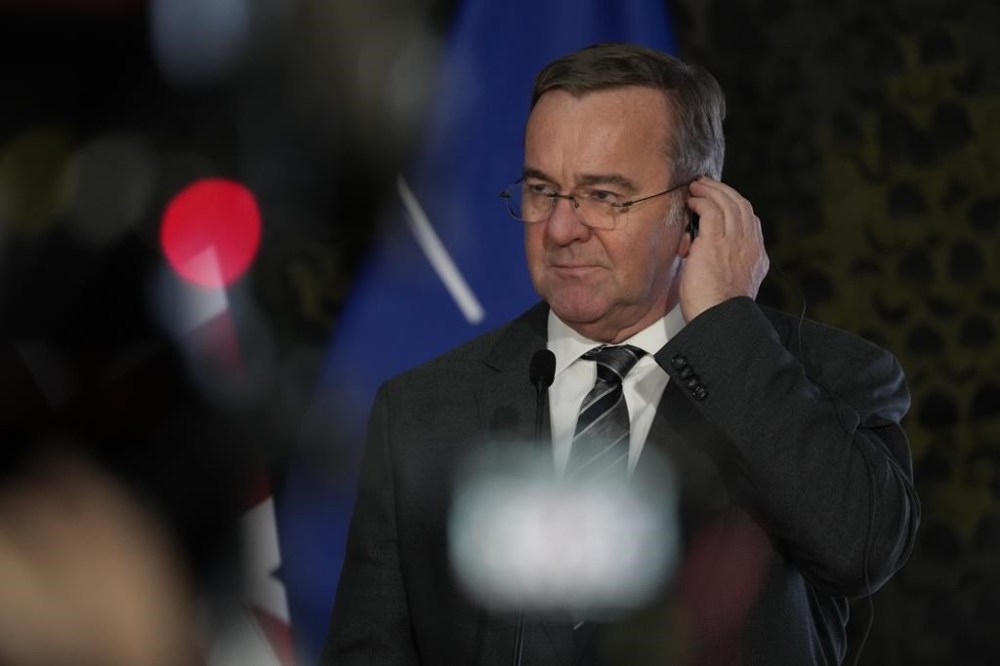Zelenskyy, Macron discuss Western troop deployment in Ukraine before German defense chief visits
Advertisement
Read this article for free:
or
Already have an account? Log in here »
To continue reading, please subscribe:
Monthly Digital Subscription
$0 for the first 4 weeks*
- Enjoy unlimited reading on winnipegfreepress.com
- Read the E-Edition, our digital replica newspaper
- Access News Break, our award-winning app
- Play interactive puzzles
*No charge for 4 weeks then price increases to the regular rate of $19.00 plus GST every four weeks. Offer available to new and qualified returning subscribers only. Cancel any time.
Monthly Digital Subscription
$4.75/week*
- Enjoy unlimited reading on winnipegfreepress.com
- Read the E-Edition, our digital replica newspaper
- Access News Break, our award-winning app
- Play interactive puzzles
*Billed as $19 plus GST every four weeks. Cancel any time.
To continue reading, please subscribe:
Add Free Press access to your Brandon Sun subscription for only an additional
$1 for the first 4 weeks*
*Your next subscription payment will increase by $1.00 and you will be charged $16.99 plus GST for four weeks. After four weeks, your payment will increase to $23.99 plus GST every four weeks.
Read unlimited articles for free today:
or
Already have an account? Log in here »
Hey there, time traveller!
This article was published 14/01/2025 (297 days ago), so information in it may no longer be current.
KYIV, Ukraine (AP) — Ukrainian President Volodymyr Zelenskyy said that he has held further discussions with French President Emmanuel Macron about the possibility of Western troops deploying in Ukraine to safeguard any peace deal ending the nearly three-year war with Russia.
Zelenskyy’s disclosure came before an official visit to Kyiv on Tuesday by German Defense Minister Boris Pistorius. He arrived in Kyiv on an unannounced visit following a meeting in Warsaw on Monday with his counterparts from France, the United Kingdom, Italy and Poland.
Germany and the four other countries are Europe’s five top military spenders.

Pistorius told German news agency dpa that his visit to Kyiv aims to underscore Germany’s strong support for Ukraine at a time when U.S. President-elect Donald Trump’s term beginning next week looks set to bring deep changes to Washington’s policy on the war.
Pistorius said that his visit “is a signal that Germany, as the biggest NATO country in Europe, stands by Ukraine — not alone, but with the group of five and many other allies.”
Trump has criticized the cost of the war for U.S. taxpayers through major military aid packages for Ukraine, and vowed to bring the conflict to a swift end. He also has made it clear that he wants to shift more of the Ukraine burden onto Europe.
Macron prompted an outcry from other leaders, and he appeared isolated on the European stage, after his remarks almost a year ago floated the possibility of putting Western troops in Ukraine.
Pistorius told reporters in Kyiv that the Warsaw meeting didn’t discuss Macron’s remarks about troop deployments.
Zelenskyy has said that Ukraine needs security guarantees to bolster any peace agreement — an issue he said late Monday that he discussed with the French leader.
“As one of these guarantees, we discussed the French initiative to deploy military contingents in Ukraine,” Zelenskyy said. “We considered practical steps for its implementation, possible expansion and involvement of other countries in this process.”
Potentially sending European troops as peacekeepers to Ukraine is fraught with risk. Such a move may not deter Russia from attacking Ukraine again in the future, which is the fear of Ukrainian officials, and could drag European countries into a direct confrontation with Moscow. That, in turn, could pull NATO — including the United States — into a conflict.
Russia’s bigger army has largely pinned Ukrainian forces on the defensive along the around 1,000-kilometer (600-mile) front line. Ukraine’s defenses are creaking in the eastern Donetsk region amid a Russian onslaught.
Zelenskyy said Ukraine has more than 100 brigades on the battlefield and each of them requires equipment replenishment before potentially increasing the number of troops through a wider mobilization.
Ukraine has built up a domestic arsenal of long-range drones and missiles that it uses to hit targets on Russian soil far behind the front line. The targets are usually infrastructure that supports the Russian war effort, such as arms depots, oil refineries and manufacturing plants.

The Ukrainian General Staff on Tuesday claimed a series of successful attacks on three Russian regions and Russia’s Republic of Tatarstan, reaching some 1,100 kilometers (almost 700 miles) into Russia.
It said in a report that among the targets struck were an oil refinery and a fuel storage depot, a chemical plant producing ammunition, and two anti-aircraft missile systems.
Russian authorities did not report any major damage or injuries from recent aerial attacks.
The Russian Defense Ministry accused Ukraine of firing six U.S.-made ATACMS missiles, six U.K.-supplied Storm Shadow missiles and 31 drones at Russia’s Bryansk region on the border with Ukraine.
All the missiles and drones were shot down by air defense systems, the ministry claimed in an online statement, but it said that the attack “will not go unanswered.”
Russia has repeatedly threatened Ukraine and the West with retaliation for the use of Western-supplied longer-range weapons to strike Russian soil.
——
Follow AP’s coverage of the war in Ukraine at https://apnews.com/hub/russia-ukraine







